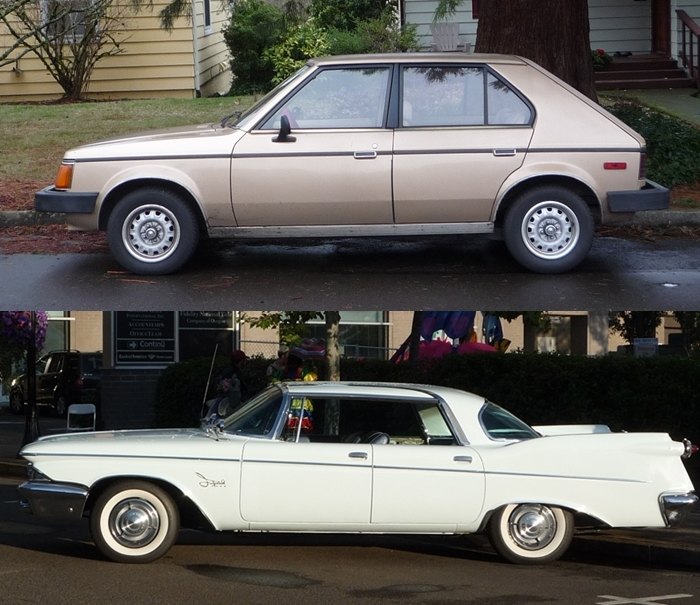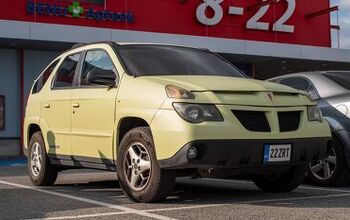Curbside Classics: Plymouth Horizon and Dodge Omni – Detroit Finally Builds A Proper Small Car

Is time slowing down? Just fifteen years separate this 1960 Imperial and the Horizon’s birth. Or was it just that Detroit was terribly slow to embrace the inevitability of modern European design? Better late then never, because not only were the Horizon and Omni the first proper small cars ever built in Detroit, they also saved Chrysler from irrelevance and bankruptcy just in the nick of time.
Before we turn the clock back and rediscover the origins of Omnirizon twins, let’s briefly put that fifteen year span between the Imperial and Horizon in perspective:
Thirty five years separate the Horizon from this 2010 Golf. Has automotive evolution really slowed down that much? Unfair comparison, perhaps. Well, there is no 2010 Imperial to compare it, since that species long ago became extinct. And the Golf does loom large in the Horizon’s existence. Or is it the other way around?
Our timeless main story begins with the Simca 1100 (at the left on the top, and right on the bottom, mislabeled as an R12). This photo is here courtesy of allpar.com, which has an excellent article about the birth of the Horizon by its creators here. We see it in a comparison of the C2 Horizon’s proposal with the brand new Golf . The C2 was the intended replacement for the Simca, and it’s easy to see that they (Simca, C2) sat on the same platform and followed its general shape.
When the Simca 1100/1204 first appeared in 1967, it set the template for the modern hatchback small car. It was the true winner of our CC virtual 1971 Small Car Comparison, and one of the first cars to employ that template was the 1975 VW Golf. Some of the Chrysler fan-boys at allpar argue that the Golf imitated the Simca. Conceptually yes; stylistically, the photo above is the damming evidence that once the Golf appeared, Chrysler’s fine tuning of their C2 proposal was deeply influenced by it, to put it politely.
The final of our comparison photos: the evidence is all too obvious, right down to the kink in the rear door. Well, if you’re going to imitate, the original Golf was certainly a good model, and it was a sight cheaper than hiring Guigiaro, like VW did.
The development of the Horizon has other compelling aspects beyond the cribbing. As the headline says, it was the first time one of the Big Three pulled its head out of its ass and decided that a modern FWD European design did actually make more sense for a small car than the crap it came up with by itself: the Chevy Vega, Ford Pinto and AMC Gremlin. In case you’ve forgotten, click the links, but in a nutshell, Detroit was obsessed with the idea that small cars needed to look like a shrunken Mustang or Camaro. Combined with RWD meant that they were atrociously cramped, especially in the rear. Perhaps they were punishing their buyers for being so stupid to want a small car instead of a real car.
It didn’t have to be that way, and cars like the Simca 1100 and the Golf showed the way. Certainly, by today’s standards they are quite small indeed, perhaps like a Fiesta or less. But at the time, when even cars like the over sized Nova were none too roomy, this was a revelation. And the Horizon was bigger than the Golf, by far the roomiest of any small car at the time.
Chrysler, fortunately lacking the funds to join the Vega-Pinto debacle, looked to its European subsidiary for a life-line, having already been convinced of the Simca 1100’s capabilities, despite its poor sales in the US and reliability issues. In a very closely coordinated effort, Chrysler undertook a three-way development effort with its French and British units. That presented huge challenges, given the substantially different priorities and the metric-inch divide. But the body was fine tuned on both sides of the continent, and for the fist time ever, digital scans of the clays were exchanged via satellite. A first, and not bad for 1975.
It became clear early on that the US version would be a very different car except for the basic body. Well, at least that was shared. The Simca’s supple but more expensive long-stroke torsion bar suspension was jettisoned for more pragmatic MacPherson struts in the front. Americans just didn’t deserve or wouldn’t appreciate that famous French ride. On the other hand, the Americans wisely stayed clear of the Simca engine, which was generally fragile and usually developed terrible valve clatter within 20k miles or so. In another nod to the Golf, Chrysler instead bought engines from VW, a 1,7 L version of the Golf’s 827 engine. Chrysler added its own manifold and cantankerous carb, foolishly eschewing fuel injection for several more years.
The Americans also developed the front automatic transaxle, a miniaturized TorqueFlite, which turned out to be pleasantly similar to its big brother reliability wise (whew!). And it brought its electronic prowess to both versions, with the first popular priced trip computer. Of course, the domestic version got an interior more in keeping with the um…slower to develop taste of Americans at the time. Still, it was a refreshing place to sit in the late seventies era of bordello interiors, with excellent visibility and decent ergonomics for the times.
Either way, the Horizons on both sides of the Atlantic were well received by the press, both winning respective COTY awards. That may have meant more in Europe, where it’s voted on by hundreds of auto journalists. Still, the American press and public reception was pretty universally positive, even though it was clear that the Horizon was not a Golf in certain key respects, mainly in the handling department. The Omnirizon’s suspension was Americanized in more ways than one. Its handling was decent for the times, but just neither actually fun nor inspiring.
Maybe that was a worthwhile trade off for the American versions’ much better rustproofing; the Euro Horizons were some of the worst rusters ever, and there may likely be less than 200 examples left on the whole continent. I’m sure I could find that many in Oregon. Our city water and electric utility had a fleet of them until just a couple of years ago.
Of course, those were undoubtedly from the latter years of the Omnirizon’s long US run from 1978 through 1990. And typical for American small cars, they slowly got better and better, later adopting the Chrysler 2.2 L four, fuel injection, and a 1.6 liter Peugeot engine as the base mill. Meanwhile though, cars like the Civic, Corolla and Mazda GLC/323 were evolving at a much quicker pace.
So even though the Omnirizons were pretty progressive when they arrived, time in the eighties was not standing still. The Japanese upsurge kept Omnirizon sales in check, although in its first three years it averaged over 200k units and some 1.8 million were sold during the whole run. Those first couple of years were critical, because Chrysler was in the depth of its brush with bankruptcy, largely in part because its big cars were obsolete or stinkers.
But it wasn’t just the sales numbers alone. Without the Horizon and Omni, it’s highly doubtful Chrysler would have been able to develop their K-Cars in time and on budget, or at all. Chrysler had a huge head start with the Horizon and its fwd transaxle, and Lee Ioacocca could prove to his Washington DC bankers that he really did have that leading edge fwd technology, the equivalent of GM and its Volt today.
Of course, the legendary hi-po versions of the Omni developed with Carroll Shelby can’t be ignored here, although the odds of finding one on the street are slim indeed. But starting with the 1984 GLH (“Goes Like Hell”), the VW GTI had a wild and woolly competitor. The first version was actually the most GTI-like, with the 110 hp tweaked 2.2. The optional 146 turbo version was already something different altogether. But then the GLHS appeared with an uprated 175 hp turbo. A crude and rude little beast it was; the wildest combination of torque steer and turbo lag bang for the buck.
The Omnirizon twins did nothing to stave of the Japanese invasion of the coasts or dissuade VW lovers from their Rabbits, but they did finally expose heartland Americans to what a proper small car could be, including a fitting hot-rod version of it. For that, it deserves a special place in my history book. And if Chrysler had kept developing it properly, my last combination picture could be comparing an original Horizon with a 2010 Horizon. Oops; make that a 2010 Omni.
No such luck; Chrysler decided small cars should look like a trucky SUV. Well, the Caliber’s replacement will be based on a European Fiat. So maybe automotive time hasn’t slowed down; it’s just running in circles.

More by Paul Niedermeyer
Latest Car Reviews
Read moreLatest Product Reviews
Read moreRecent Comments
- Doug brockman There will be many many people living in apartments without dedicated charging facilities in future who will need personal vehicles to get to work and school and for whom mass transit will be an annoying inconvenience
- Jeff Self driving cars are not ready for prime time.
- Lichtronamo Watch as the non-us based automakers shift more production to Mexico in the future.
- 28-Cars-Later " Electrek recently dug around in Tesla’s online parts catalog and found that the windshield costs a whopping $1,900 to replace.To be fair, that’s around what a Mercedes S-Class or Rivian windshield costs, but the Tesla’s glass is unique because of its shape. It’s also worth noting that most insurance plans have glass replacement options that can make the repair a low- or zero-cost issue. "Now I understand why my insurance is so high despite no claims for years and about 7,500 annual miles between three cars.
- AMcA My theory is that that when the Big 3 gave away the store to the UAW in the last contract, there was a side deal in which the UAW promised to go after the non-organized transplant plants. Even the UAW understands that if the wage differential gets too high it's gonna kill the golden goose.











































Comments
Join the conversation
I purchased a 1980 Dodge Omni this last year with only 66k on the odometer for $700, It's the cleanest example that I, and most other I've shown it to, have ever seen(minus paintwork). I only drive it around town, and it may have some carb problems now and then... but on a good day when it starts fine, and I take it through the canyon... its the most enjoyable little car I have ever driven and I wouldn't give it up for $1million